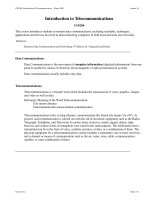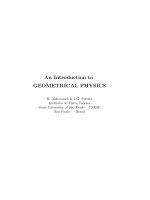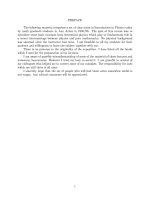Introduction to Quantum Physics
Bạn đang xem bản rút gọn của tài liệu. Xem và tải ngay bản đầy đủ của tài liệu tại đây (493.77 KB, 3 trang )
Introduction to Quantum Physics
Introduction to Quantum
Physics
Bởi:
OpenStaxCollege
A black fly imaged by an electron microscope is as monstrous as any science-fiction creature.
(credit: U.S. Department of Agriculture via Wikimedia Commons)
1/3
Introduction to Quantum Physics
Quantum mechanics is the branch of physics needed to deal with submicroscopic
objects. Because these objects are smaller than we can observe directly with our senses
and generally must be observed with the aid of instruments, parts of quantum mechanics
seem as foreign and bizarre as parts of relativity. But, like relativity, quantum mechanics
has been shown to be valid—truth is often stranger than fiction.
Certain aspects of quantum mechanics are familiar to us. We accept as fact that matter
is composed of atoms, the smallest unit of an element, and that these atoms combine
to form molecules, the smallest unit of a compound. (See [link].) While we cannot
see the individual water molecules in a stream, for example, we are aware that this
is because molecules are so small and so numerous in that stream. When introducing
atoms, we commonly say that electrons orbit atoms in discrete shells around a tiny
nucleus, itself composed of smaller particles called protons and neutrons. We are also
aware that electric charge comes in tiny units carried almost entirely by electrons and
protons. As with water molecules in a stream, we do not notice individual charges in
the current through a lightbulb, because the charges are so small and so numerous in the
macroscopic situations we sense directly.
Atoms and their substructure are familiar examples of objects that require quantum mechanics
to be fully explained. Certain of their characteristics, such as the discrete electron shells, are
classical physics explanations. In quantum mechanics we conceptualize discrete “electron
clouds” around the nucleus.
Making Connections: Realms of Physics
Classical physics is a good approximation of modern physics under conditions first
discussed in the The Nature of Science and Physics. Quantum mechanics is valid in
general, and it must be used rather than classical physics to describe small objects, such
as atoms.
Atoms, molecules, and fundamental electron and proton charges are all examples of
physical entities that are quantized—that is, they appear only in certain discrete values
and do not have every conceivable value. Quantized is the opposite of continuous. We
cannot have a fraction of an atom, or part of an electron’s charge, or 14-1/3 cents,
for example. Rather, everything is built of integral multiples of these substructures.
Quantum physics is the branch of physics that deals with small objects and the
quantization of various entities, including energy and angular momentum. Just as with
classical physics, quantum physics has several subfields, such as mechanics and the
2/3
Introduction to Quantum Physics
study of electromagnetic forces. The correspondence principle states that in the classical
limit (large, slow-moving objects), quantum mechanics becomes the same as classical
physics. In this chapter, we begin the development of quantum mechanics and its
description of the strange submicroscopic world. In later chapters, we will examine
many areas, such as atomic and nuclear physics, in which quantum mechanics is crucial.
3/3









